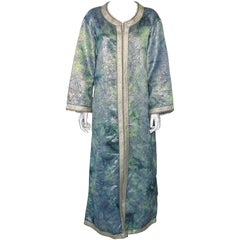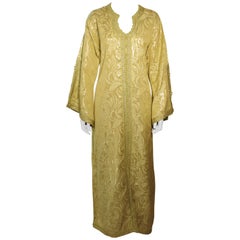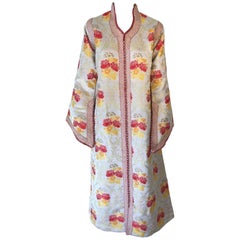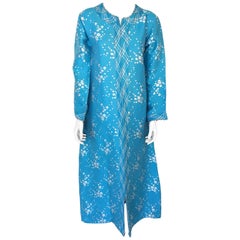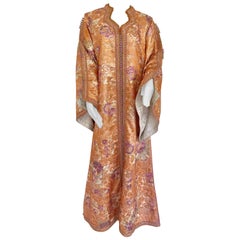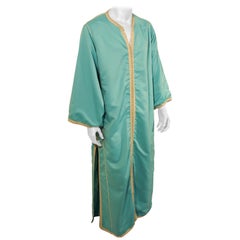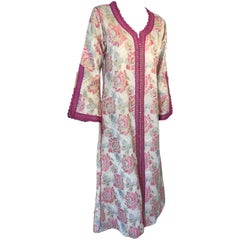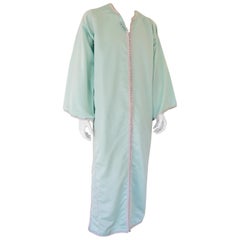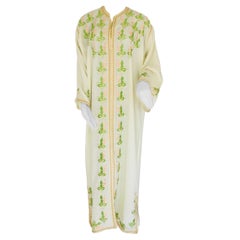Moorish Caftan
Mid-20th Century Moroccan Bohemian Textiles
Brocade
20th Century Moroccan Moorish Textiles
Brocade
20th Century Moroccan Islamic Textiles
Brocade
20th Century Moroccan Moorish Textiles
Brocade
20th Century Moroccan Moorish Textiles
Brocade
Late 20th Century Moroccan Moorish Textiles
Braid
20th Century Moroccan Moorish Textiles
Brocade
Late 20th Century Moroccan Moorish Textiles
Braid
20th Century Moroccan Moorish Textiles
Fabric
20th Century Moroccan Moorish Textiles
Fabric
20th Century Moroccan Moorish Textiles
Fabric
20th Century Moroccan Moorish Textiles
Fabric
20th Century Moroccan Moorish Textiles
Fabric
20th Century Moroccan Moorish Textiles
Cotton
Late 20th Century Moroccan Moorish Textiles
Braid
Vintage 1960s Moroccan Moorish Textiles
Metallic Thread, Gold
20th Century Moroccan Moorish Textiles
Fabric
Vintage 1960s Moroccan Moorish Textiles
Gold, Metallic Thread
20th Century Moroccan Moorish Textiles
Fabric
Vintage 1970s Moroccan Moorish Textiles
Brocade, Braid
20th Century Moroccan Moorish Textiles
Fabric
20th Century Moroccan Moorish Textiles
Fabric
Vintage 1960s Moroccan Moorish Collectible Jewelry
Metallic Thread, Gold
20th Century Moroccan Moorish Textiles
Fabric
20th Century Moroccan Moorish Textiles
Fabric
20th Century Moroccan Moorish Textiles
Brocade
Mid-20th Century Moroccan Moorish Textiles
Damask
20th Century Moroccan Moorish Textiles
Velvet
20th Century Moroccan Moorish Textiles
Brocade
Antique 19th Century Unknown Moorish Quilts and Blankets
Fabric
20th Century Moroccan Moorish Textiles
Fabric
20th Century Moroccan Moorish Decorative Art
Brocade
Vintage 1960s Moroccan Moorish Collectible Jewelry
Metallic Thread
20th Century Moroccan Moorish Textiles
Brocade, Braid
20th Century Moroccan Moorish Textiles
Brocade, Braid
Vintage 1960s Moroccan Moorish Textiles
Metallic Thread
20th Century Moroccan Moorish Textiles
Brocade
Late 20th Century Moroccan Moorish Textiles
Metallic Thread
20th Century Moroccan Moorish Textiles
Brocade, Braid
20th Century Moroccan Moorish Textiles
Brocade, Silk
Late 20th Century Moroccan Moorish Textiles
Metallic Thread
Late 20th Century Moroccan Moorish Textiles
Metallic Thread
20th Century Moroccan Bohemian Textiles
Cotton
Vintage 1970s Moroccan Moorish Textiles
Gold, Metallic Thread
20th Century Moroccan Bohemian Textiles
Fabric
20th Century Moroccan Bohemian Textiles
Velvet
20th Century Moroccan Moorish Textiles
Fabric
20th Century Moroccan Moorish Textiles
Fabric
20th Century Moroccan Moorish Textiles
Fabric
20th Century Moroccan Moorish Textiles
Fabric
20th Century Moroccan Moorish Textiles
Fabric
20th Century Moroccan Moorish Textiles
Silk
20th Century Moroccan Moorish Textiles
Brocade
Vintage 1970s Moroccan Moorish Textiles
Brocade, Silk, Braid
20th Century Moroccan Moorish Textiles
Fabric
20th Century Moroccan Moorish Textiles
Velvet
20th Century Moroccan Moorish Textiles
Satin
20th Century Moroccan Bohemian Textiles
Brocade
20th Century Moroccan Bohemian Textiles
Velvet
20th Century Moroccan Moorish Textiles
Brocade, Silk
- 1
Moorish Caftan For Sale on 1stDibs
How Much is a Moorish Caftan?
A Close Look at Moorish Furniture
After the Muslim conquest of the Iberian Peninsula in the eighth century, Islamic Spain became a cultural mix of influences that shaped both private homes and religious spaces. Moorish design was the name given to this style, which evolved through the 15th century with vibrant tile work, horseshoe arches and lavish ornamentation, most visible at sites such as Granada’s Alhambra and the Mosque-Cathedral of Córdoba. Moorish furniture was often similarly ornate, and featured pieces inlaid with wood, ivory and bone.
When European designers began studying Moorish art and architecture in the early 19th century, it led to a Moorish Revival. Appropriating the style’s decorative flourishes and architectural elements, it promoted a romantic view of Islamic design. Travelers could bring home a memento of what they witnessed in the Middle East, a trend that aligned with a fad for themed interiors. Men’s smoking rooms arranged with ottomans, divans and settees and inlaid tables were especially popular, as were cafés where coffee was served amid bead curtains and colorful floor mats. (Handwoven rugs are a centerpiece of Moorish interiors.) Octagonal rooms with domed ceilings were created for wealthy homes, frequently with furnishings like pipe stands, filigree plasterwork and arched doorways. The horseshoe arch is an iconic attribute of Moorish architecture that, in addition to Spain, can be found in Sicily, Morocco and elsewhere.
Several late 19th to early 20th-century movements featured Moorish touches. The American and English Aesthetic Movement, for example, borrowed liberally from global decorating styles, as seen in furniture designed by Lockwood de Forest, a New York-born artist who mixed Eastern and Western forms. The visual vocabulary of Art Nouveau also references the elegant use of geometry in Moorish design, with Milanese Art Nouveau furniture designer Carlo Bugatti drawing inspiration from the style. The Arts and Crafts movement, which prized expressive yet simple design, incorporated Moorish influences; hand-painted furniture and tile work created by William De Morgan, a British designer and potter who made furnishings for the likes of Morris & Co., were informed by techniques from Moorish Spain.
Find a collection of Moorish lighting, decorative objects, folk art and more furniture on 1stDibs.
Finding the Right Asian Art And Furniture for You
From Japanese handmade earthenware pottery, originating circa 14,500 B.C. and adorned with elaborate corded patterns known as jōmon, to natural elm case pieces and storage cabinets built in Qing dynasty–era China to mid-century Thai rice-paper charcoal rubbings, antique and vintage Asian art and furniture make for wonderful additions to all kinds of contemporary interiors.
Eastern elements elevate any home’s decor. Introduce zen sensibility to your living room, dining room and bedroom with the neutral color palettes and the natural materials such as rattan, bamboo and elm that we typically associate with traditional Asian furniture. Decorative handwoven embroideries and textiles originating from India and elsewhere on the continent, which can be draped over a bed or sofa or used as a wall hanging, can be as practical as they are functional, just as you wouldn’t seek out Japanese room-divider screens — often decorated with paintings but constructed to be lightweight and mobile — merely for privacy.
With everything from blanket chests to lighting fixtures to sculptures and carvings, it’s easy to tastefully bring serenity to your living space by looking to the treasures for which the East has long been known.
For British-born furniture designer Andrianna Shamaris, the Japanese concept of beauty in imperfection isn’t limited to her Wabi Sabi collection. She embraces it in her New York City apartment as well. In the living area, for instance, she retained the fireplace’s original black marble while swathing its frame and the rest of the room in bright white.
“We left the fireplace very clean and wabi-sabi, so that it blended into the wall,” says Shamaris, who further appointed the space with a hand-carved antique daybed whose plush pillows are upholstered in antique textiles from the Indonesian island of Sumba.
In the growing antique and vintage Asian art and furniture collection on 1stDibs, find ceramics from China, antiquities from Cambodia and a vast range of tables, seating, dining chairs and other items from Japan, India and other countries.
